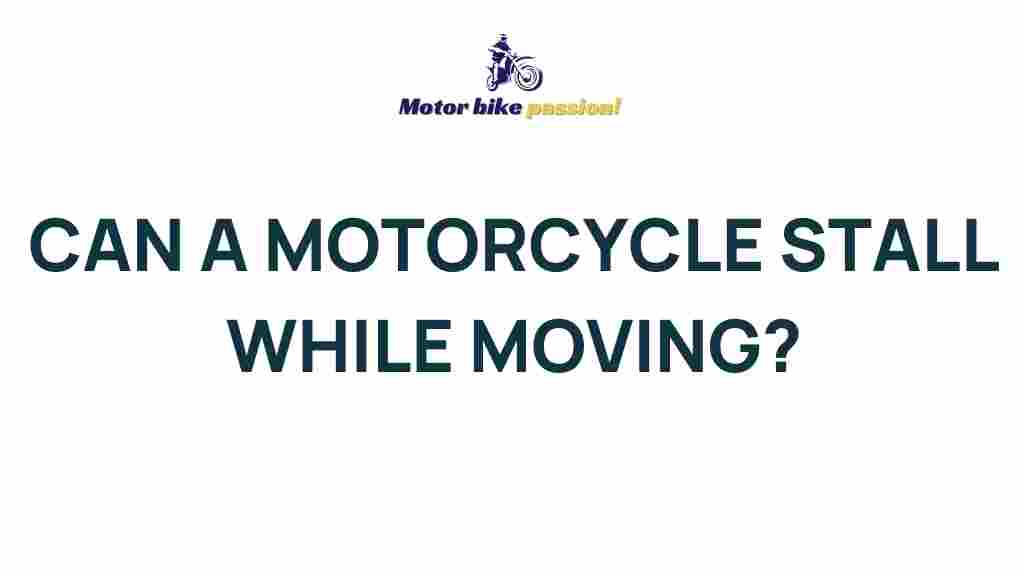The Mystery of Motorcycle Stalling: Can It Happen While Moving?
Motorcycles are thrilling machines that offer a sense of freedom and adventure. However, experiencing a motorcycle stall while moving can be a daunting and potentially dangerous situation. Understanding the reasons behind this phenomenon and how to troubleshoot it is vital for every rider’s safety. In this article, we will explore why a motorcycle may stall while in motion, how to troubleshoot the issue, and best practices for ensuring your ride remains smooth and safe.
Understanding Motorcycle Stalling
Before diving into troubleshooting, it’s essential to understand what stalling means in the context of motorcycles. Stalling occurs when the engine stops running while the motorcycle is still in motion. This can happen for various reasons, including improper throttle control, clutch issues, or engine malfunctions. Here are some common causes of motorcycle stalling while moving:
- Throttle Control: Improper use of the throttle can lead to stalling. Riders may inadvertently close the throttle too quickly, causing the engine to lose power.
- Clutch Issues: Engaging and disengaging the clutch incorrectly can also result in a stall. If the clutch is not fully engaged while shifting, the engine might stall.
- Speed: Riding at low speeds without sufficient throttle can make it challenging for the engine to maintain power, leading to a stall.
- Fuel Supply: Insufficient fuel supply due to a malfunctioning fuel pump or clogged fuel lines can cause the engine to stall.
- Electrical Issues: Problems with the motorcycle’s electrical system, such as a dead battery or faulty wiring, can result in unexpected stalling.
The Importance of Safety While Riding
When riding a motorcycle, safety should always be the top priority. A stall while moving can lead to critical situations, especially in traffic. Here are some safety tips to avoid stalling:
- Practice Throttle Control: Familiarize yourself with your motorcycle’s throttle response. Gradually apply and release the throttle to maintain engine power.
- Clutch Engagement: Learn to engage the clutch smoothly and fully when shifting gears to prevent stalling.
- Maintain Speed: Keep an eye on your speed, especially when approaching stops or during low-speed maneuvers.
- Regular Maintenance: Ensure your motorcycle is regularly serviced to prevent mechanical failures that could lead to stalling.
Step-by-Step Troubleshooting for Motorcycle Stalling
If you find yourself facing a stall while riding, here is a step-by-step troubleshooting guide to help you diagnose the issue:
1. Assess Your Throttle Control
When your motorcycle stalls, the first step is to evaluate your throttle control. If you’ve closed the throttle too quickly, try the following:
- Gradually open the throttle to see if the engine responds.
- Practice smooth transitions between throttle and no throttle at lower speeds.
2. Check Clutch Operation
Next, inspect your clutch operation:
- Ensure that you are fully pulling in the clutch when shifting.
- Test the clutch lever for proper function; it should feel smooth and not stick.
- If your motorcycle has a hydraulic clutch, check for fluid levels and leaks.
3. Evaluate Your Speed
Low-speed riding can increase the likelihood of stalling. Consider the following:
- Maintain a minimum speed that allows the engine to run efficiently without stalling.
- In stop-and-go traffic, keep your RPMs up by using the throttle appropriately.
4. Inspect Fuel Supply
If you suspect fuel issues, follow these steps:
- Check your fuel gauge to ensure you have enough fuel.
- Inspect the fuel lines for clogs or leaks.
- Listen for the fuel pump’s sound when turning on the ignition; it should make a whirring noise.
5. Examine Electrical Systems
Lastly, evaluate the electrical systems:
- Check the battery for charge and connections.
- Inspect wiring for any visible damage or disconnections.
- Consider testing fuses related to the engine management system.
Common Troubleshooting Tips
In addition to the step-by-step process above, here are some common troubleshooting tips to consider when dealing with motorcycle stalling:
- Keep Your Motorcycle Maintained: Regular oil changes, air filter replacements, and tune-ups can prevent many engine issues.
- Use High-Quality Fuel: Low-quality fuel can lead to engine performance issues. Always use fuel that meets the manufacturer’s specifications.
- Watch for Warning Lights: Pay attention to any warning lights on your dashboard. These can indicate problems that may lead to stalling.
- Consult the Owner’s Manual: Refer to your motorcycle’s owner’s manual for specific troubleshooting guidelines related to your model.
When to Seek Professional Help
While many stalling issues can be resolved with basic troubleshooting, there are times when it’s best to seek professional help:
- If you are uncomfortable performing maintenance or repairs yourself.
- If the motorcycle continues to stall despite your efforts to troubleshoot.
- If you notice unusual sounds, smells, or warning lights that indicate a serious issue.
In these cases, visiting a certified mechanic or a motorcycle repair shop is the best course of action to ensure your motorcycle is safe and reliable.
For more detailed troubleshooting tips, you can check out this comprehensive guide on motorcycle maintenance.
Conclusion
Motorcycle stalling while moving can be a frightening experience, but understanding the causes and having a plan for troubleshooting can help mitigate risks. Always prioritize safety by practicing good throttle control, ensuring proper clutch operation, and maintaining your motorcycle in top condition. By following the tips outlined in this article, you can reduce the chances of experiencing a stall while riding and enjoy a smoother, safer journey on your motorcycle.
For more information on motorcycle safety and maintenance, visit this resource for expert advice and tips.
This article is in the category Safe Driving and created by MotorBikePassion Team
